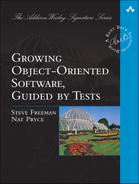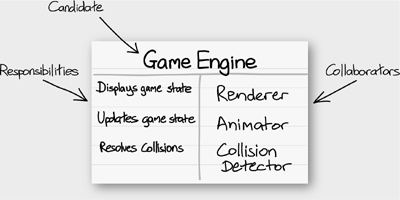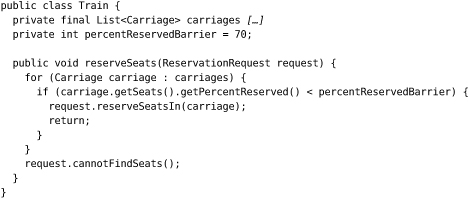Chapter 2. Test-Driven Development with Objects
Music is the space between the notes.
—Claude Debussy
A Web of Objects
Object-oriented design focuses more on the communication between objects than on the objects themselves. As Alan Kay [Kay98] wrote:
The big idea is “messaging” [...] The key in making great and growable systems is much more to design how its modules communicate rather than what their internal properties and behaviors should be.
An object communicates by messages: It receives messages from other objects and reacts by sending messages to other objects as well as, perhaps, returning a value or exception to the original sender. An object has a method of handling every type of message that it understands and, in most cases, encapsulates some internal state that it uses to coordinate its communication with other objects.
An object-oriented system is a web of collaborating objects. A system is built by creating objects and plugging them together so that they can send messages to one another. The behavior of the system is an emergent property of the composition of the objects—the choice of objects and how they are connected (Figure 2.1).
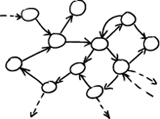
This lets us change the behavior of the system by changing the composition of its objects—adding and removing instances, plugging different combinations together—rather than writing procedural code. The code we write to manage this composition is a declarative definition of the how the web of objects will behave. It’s easier to change the system’s behavior because we can focus on what we want it to do, not how.
Values and Objects
When designing a system, it’s important to distinguish between values that model unchanging quantities or measurements, and objects that have an identity, might change state over time, and model computational processes. In the object-oriented languages that most of us use, the confusion is that both concepts are implemented by the same language construct: classes.
Values are immutable instances that model fixed quantities. They have no individual identity, so two value instances are effectively the same if they have the same state. This means that it makes no sense to compare the identity of two values; doing so can cause some subtle bugs—think of the different ways of comparing two copies of new Integer(999). That’s why we’re taught to use string1.equals(string2) in Java rather than string1 == string2.
Objects, on the other hand, use mutable state to model their behavior over time. Two objects of the same type have separate identities even if they have exactly the same state now, because their states can diverge if they receive different messages in the future.
In practice, this means that we split our system into two “worlds”: values, which are treated functionally, and objects, which implement the stateful behavior of the system. In Part III, you’ll see how our coding style varies depending on which world we’re working in.
In this book, we will use the term object to refer only to instances with identity, state, and processing—not values. There doesn’t appear to be another accepted term that isn’t overloaded with other meanings (such as entity and process).
Follow the Messages
We can benefit from this high-level, declarative approach only if our objects are designed to be easily pluggable. In practice, this means that they follow common communication patterns and that the dependencies between them are made explicit. A communication pattern is a set of rules that govern how a group of objects talk to each other: the roles they play, what messages they can send and when, and so on. In languages like Java, we identify object roles with (abstract) interfaces, rather than (concrete) classes—although interfaces don’t define everything we need to say.
In our view, the domain model is in these communication patterns, because they are what gives meaning to the universe of possible relationships between the objects. Thinking of a system in terms of its dynamic, communication structure is a significant mental shift from the static classification that most of us learn when being introduced to objects. The domain model isn’t even obviously visible because the communication patterns are not explicitly represented in the programming languages we get to work with. We hope to show, in this book, how tests and mock objects help us see the communication between our objects more clearly.
Here’s a small example of how focusing on the communication between objects guides design.
In a video game, the objects in play might include: actors, such as the player and the enemies; scenery, which the player flies over; obstacles, which the player can crash into; and effects, such as explosions and smoke. There are also scripts spawning objects behind the scenes as the game progresses.
This is a good classification of the game objects from the players’ point of view because it supports the decisions they need to make when playing the game—when interacting with the game from outside. This is not, however, a useful classification for the implementers of the game. The game engine has to display objects that are visible, tell objects that are animated about the passing of time, detect collisions between objects that are physical, and delegate decisions about what to do when physical objects collide to collision resolvers.
As you can see in Figure 2.2, the two views, one from the game engine and one from the implementation of the in-play objects, are not the same. An Obstacle, for example, is Visible and Physical, while a Script is a Collision Resolver and Animated but not Visible. The objects in the game play different roles depending on what the engine needs from them at the time. This mismatch between static classification and dynamic communication means that we’re unlikely to come up with a tidy class hierarchy for the game objects that will also suit the needs of the engine.
Figure 2.2 Roles and objects in a video game
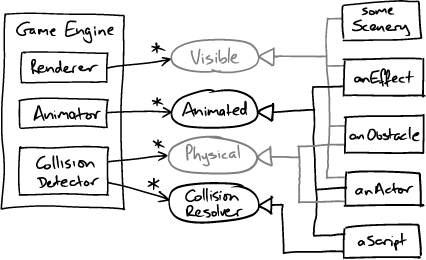
At best, a class hierarchy represents one dimension of an application, providing a mechanism for sharing implementation details between objects; for example, we might have a base class to implement the common features of frame-based animation. At worst, we’ve seen too many codebases (including our own) that suffer complexity and duplication from using one mechanism to represent multiple concepts.
Tell, Don’t Ask
We have objects sending each other messages, so what do they say? Our experience is that the calling object should describe what it wants in terms of the role that its neighbor plays, and let the called object decide how to make that happen. This is commonly known as the “Tell, Don’t Ask” style or, more formally, the Law of Demeter. Objects make their decisions based only on the information they hold internally or that which came with the triggering message; they avoid navigating to other objects to make things happen. Followed consistently, this style produces more flexible code because it’s easy to swap objects that play the same role. The caller sees nothing of their internal structure or the structure of the rest of the system behind the role interface.
When we don’t follow the style, we can end up with what’s known as “train wreck” code, where a series of getters is chained together like the carriages in a train. Here’s one case we found on the Internet:

After some head scratching, we realized what this fragment was meant to say:
master.allowSavingOfCustomisations();
This wraps all that implementation detail up behind a single call. The client of master no longer needs to know anything about the types in the chain. We’ve reduced the risk that a design change might cause ripples in remote parts of the codebase.
As well as hiding information, there’s a more subtle benefit from “Tell, Don’t Ask.” It forces us to make explicit and so name the interactions between objects, rather than leaving them implicit in the chain of getters. The shorter version above is much clearer about what it’s for, not just how it happens to be implemented.
But Sometimes Ask
Of course we don’t “tell” everything;1 we “ask” when getting information from values and collections, or when using a factory to create new objects. Occasionally, we also ask objects about their state when searching or filtering, but we still want to maintain expressiveness and avoid “train wrecks.”
1. Although that’s an interesting exercise to try, to stretch your technique.
For example (to continue with the metaphor), if we naively wanted to spread reserved seats out across the whole of a train, we might start with something like:
We shouldn’t expose the internal structure of Carriage to implement this, not least because there may be different types of carriages within a train. Instead, we should ask the question we really want answered, instead of asking for the information to help us figure out the answer ourselves:

Adding a query method moves the behavior to the most appropriate object, gives it an explanatory name, and makes it easier to test.
We try to be sparing with queries on objects (as opposed to values) because they can allow information to “leak” out of the object, making the system a little bit more rigid. At a minimum, we make a point of writing queries that describe the intention of the calling object, not just the implementation.
Unit-Testing the Collaborating Objects
We appear to have painted ourselves into a corner. We’re insisting on focused objects that send commands to each other and don’t expose any way to query their state, so it looks like we have nothing available to assert in a unit test. For example, in Figure 2.4, the circled object will send messages to one or more of its three neighbors when invoked. How can we test that it does so correctly without exposing any of its internal state?
Figure 2.4 Unit-testing an object in isolation

One option is to replace the target object’s neighbors in a test with substitutes, or mock objects, as in Figure 2.5. We can specify how we expect the target object to communicate with its mock neighbors for a triggering event; we call these specifications expectations. During the test, the mock objects assert that they have been called as expected; they also implement any stubbed behavior needed to make the rest of the test work.
Figure 2.5 Testing an object with mock objects
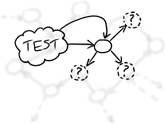
With this infrastructure in place, we can change the way we approach TDD. Figure 2.5 implies that we’re just trying to test the target object and that we already know what its neighbors look like. In practice, however, those collaborators don’t need to exist when we’re writing a unit test. We can use the test to help us tease out the supporting roles our object needs, defined as Java interfaces, and fill in real implementations as we develop the rest of the system. We call this interface discovery; you’ll see an example when we extract an AuctionEventListener in Chapter 12.
Support for TDD with Mock Objects
To support this style of test-driven programming, we need to create mock instances of the neighboring objects, define expectations on how they’re called and then check them, and implement any stub behavior we need to get through the test. In practice, the runtime structure of a test with mock objects usually looks like Figure 2.6.
Figure 2.6 Testing an object with mock objects

We use the term mockery2 for the object that holds the context of a test, creates mock objects, and manages expectations and stubbing for the test. We’ll show the practice throughout Part III, so we’ll just touch on the basics here. The essential structure of a test is:
2. This is a pun by Ivan Moore that we adopted in a fit of whimsy.
• Create any required mock objects.
• Create any real objects, including the target object.
• Specify how you expect the mock objects to be called by the target object.
• Call the triggering method(s) on the target object.
• Assert that any resulting values are valid and that all the expected calls have been made.
The unit test makes explicit the relationship between the target object and its environment. It creates all the objects in the cluster and makes assertions about the interactions between the target object and its collaborators. We can code this infrastructure by hand or, these days, use one of the multiple mock object frameworks that are available in many languages. The important point, as we stress repeatedly throughout this book, is to make clear the intention of every test, distinguishing between the tested functionality, the supporting infrastructure, and the object structure.
